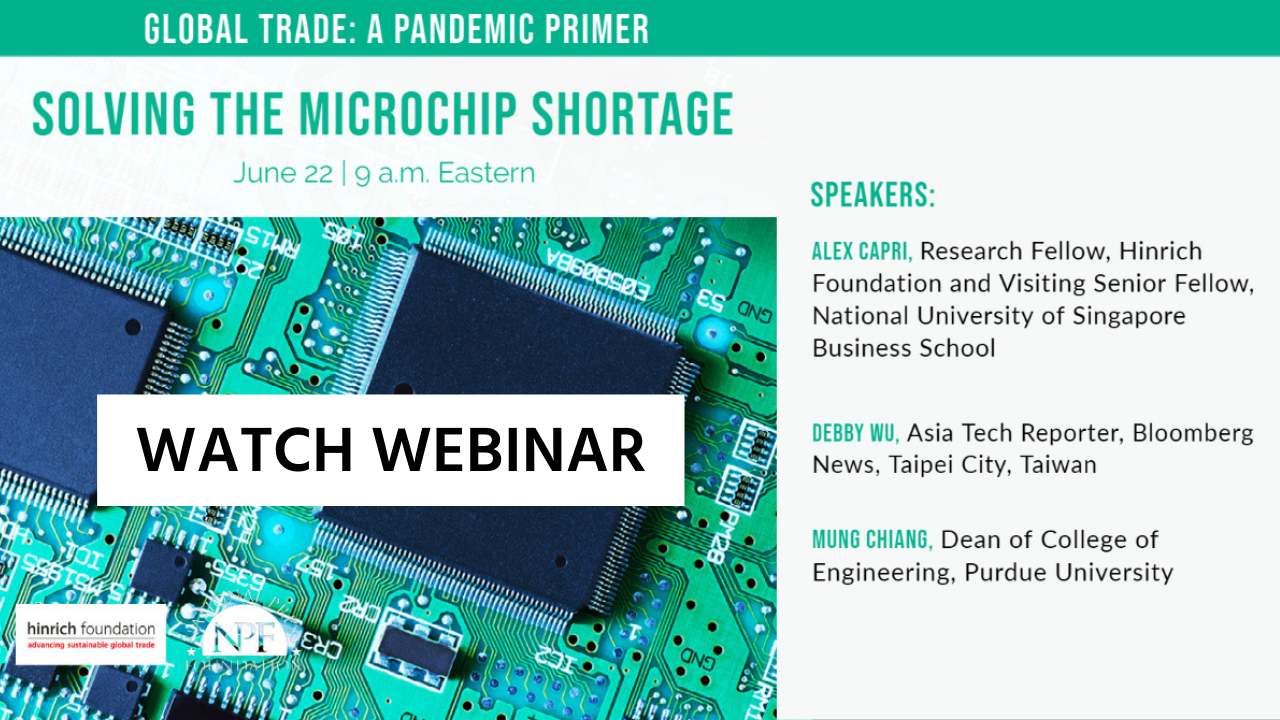Solving the microchip shortage
Published 30 June 2021
The ongoing microchip shortage are likely to extend into next year. The concentration of the semiconductor market in a few economies is the main culprit, but how did we get here? Featuring three speakers, this webinar explains the shortage's wider implications, and why the race to expand microchip production should be seen as the new moonshot.
As companies begin to feel the sting of an ongoing semiconductor shortage, leaders in the US, the EU and Asian nations are scrambling to ease the snags in the supply chains for chips — and reshore manufacturing of these vital components. Three expert speakers explained what led to this phenomenon and its significance. Here are five key takeaways:
- The semiconductor shortage exemplifies the global trend toward techno-nationalism. Alex Capri, research fellow at the Hinrich Foundation, said the current shortage of vital semiconductors is not merely a supply chain issue but one of national security. The microchips power every kind of electronic — from smartphones to cars to smart bombs and other military applications. “They are the heart and the brains of every industry of the future,” Capri said. But because they are dual-use technologies, they risk becoming subject to export controls. The most important semiconductors come from Taiwan, which is under increasing threat from China. Experts fear Beijing might resort to force to seize the island, and that in turn has rattled supply chains and policymakers who seek to reduce their dependence on foreign semiconductor manufacturing. (More from Capri on this emerging techno-nationalism.)
- The current chip shortage was 20 years in the making but has been accelerated by the pandemic. Over the past 20 years, the market for semiconductors has dwindled to three main companies — one in the U.S., one in South Korea and one in Taiwan. The most important of those semiconductors are known as advanced logic chips, and the dominant company for those chips is Taiwan Semiconductor Manufacturing Co., known as TSMC. During the pandemic, laptop sales skyrocketed as workers stayed home, as did sales of home appliances, webcams and the like. Automakers cut orders and then, when the pandemic was easing, rapidly increased them. And the U.S. crackdown on trade with Chinese smartphone maker Huawei Technologies Co. prompted that company to stockpile chips. The result: A 2021 with not enough chips available for U.S. automakers and other companies.
- Chip shortages mean fewer cars and fewer jobs than expected. Detroit particularly has been walloped by the chip shortages. Ford Motor Co. and others have announced manufacturing slowdowns because of chip shortages, which it said would cost about $2.5 billion in 2021. Stellantis NV is laying off workers in Detroit because it can’t get chips for its Jeeps. And while Wall Street analysts see some improvement, it could be a couple years before the current shortages are resolved. “Most companies agreed that the chip shortage will extend into next year,” said Debby Wu, a Bloomberg News reporter based in Taipei City, Taiwan.
- Building new capacity in the U.S. will take time. The Biden administration has laid out a plan to ramp up U.S. chip manufacturing and recommended that Congress support at least $50 billion in investments to boost semiconductor development. The Senate recently passed a bill to do so. But it will be another two years at least before new manufacturing plants are operational in the U.S. — so the moves now won’t get drivers into new cars by Labor Day 2021, or even Labor Day 2022. “We’re talking about an extremely complicated and sophisticated and precision-driven … manufacturing process,” said Mung Chiang, dean of the College of Engineering at Purdue University.
- Journalists should cover the race to expand semiconductor production as if it were the new moonshot. The technology for new semiconductors is evermore elaborate and precise. Components in development are about the width of a strand of DNA. The strategic importance of these advanced chips is growing apace. “This is the beginning of the next moonshot,” Capri said. “… If you take the race to develop the atomic bomb, the space race between the United States and the Soviet Union in the ’60s and in the ’70s, those were the first two real techno-nationalist moonshots. Semiconductors are part of the third moonshot.”
***
Telling the global trade story
This briefing is part of a series of National Press Foundation's online webinars covering all aspects of global trade. Click here to view all.
© The Hinrich Foundation. See our website Terms and conditions for our copyright and reprint policy. All statements of fact and the views, conclusions and recommendations expressed in this publication are the sole responsibility of the author(s).






